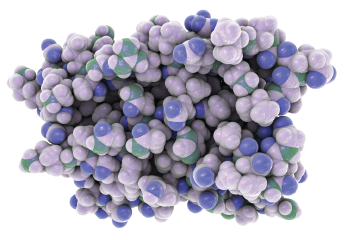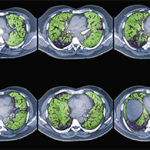
Representation of the molecular structure of interferon a.
Kateryna Kon / shutterstock.com
People with autoimmune connective tissue diseases produce antibodies against nuclear antigens up to 10 years before they develop clinical features. Anti-nuclear antibodies (ANAs) are also very common, and a small percentage of ANA-positive patients progress to clinical autoimmunity.
The question: Is there a reliable way to screen at-risk patients before they develop active autoimmunity and identify those most likely to progress?
In a new study published in the Annals of the Rheumatic Diseases, researchers at the University of Leeds Institute of Rheumatic and Musculoskeletal Medicine, England, show that a novel, two-factor interferon-stimulating gene (ISG) score, along with a family history of autoimmune rheumatic disease, predicts the progression from ANA positivity to an active autoimmune connective tissue disease (AI-CTD).1 This test could allow rheumatologists to screen at-risk patients and recommend early intervention during the subclinical autoimmunity phase. The Leeds Institute researchers are now working to replicate and validate their findings in a second cohort.
There remains a significant need for an accurate, predictive test for likely progression to autoimmunity in this patient population, says Md Yuzaiful Md Yusof, MBChB, MRCP, a rheumatologist and doctoral research fellow at the University of Leeds, and one of the study’s co-authors. The researchers’ primary goal was to find a reliable test to stratify patients at highest risk for progression and allow for early treatment to help prevent irreversible tissue damage, and reduce the need for remission induction therapy with glucocorticoids. AI-CTDs include such diseases as systemic lupus erythematosus, primary Sjögren’s syndrome, systemic sclerosis (SSc), inflammatory myopathies and mixed and undifferentiated CTDs.
“ANA positivity, as detected from a blood test, is a common finding. However, only less than 1% of individuals with a positive test progress into autoimmune connective tissue disease,” says Dr. Yusof. Because there are “limited data on reliable predictors of progression, some of these individuals may be discharged prematurely after the first consultation if they do not meet the criteria of an AI-CTD. Although it may not be cost effective to follow up all these individuals routinely in clinic, the risk of premature discharge from secondary care can lead to a delay in diagnosis, and, should they progress, this can result in damage accrual and development of comorbidities.”
Dr. Yusof
‘By screening ANA-positive individuals for the two predictors of progression identified in our study—IFN scores & a positive family history of autoimmune rheumatic diseases—those with the imminent risk of relapse can be offered early treatment to prevent severe organ involvement, organ damage & glucocorticoid use.’ —Dr. Yusof
The Interferon Pathway
The researchers focused on variants in the type-1 interferon (IFN-1) pathway because of their prominent (if still unclear) role in patients’ genetic susceptibility to AI-CTDs. In an earlier study, these researchers described a novel system using two interferon-stimulated gene (ISG) expression scores, ISG-Score-A and ISG-Score-B, which in combination identify clinically meaningful differences in interferon status between and within autoimmune diseases.2 In the current study, they set out to apply the scoring system to predict progression from at-risk status to AI-CTD.
AI-CTDs most often affect the joints and the skin, the researchers write. Although musculoskeletal ultrasound can detect subclinical synovitis in lupus, and skin biopsies can show differences in interferon gene expression in cutaneous lupus, neither test has been assessed in at-risk individuals.3,4



